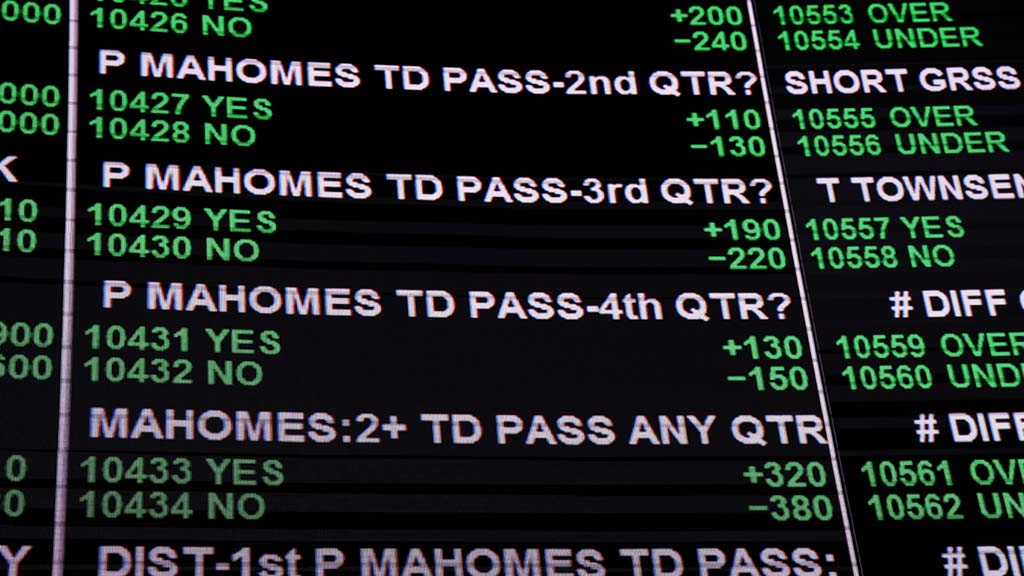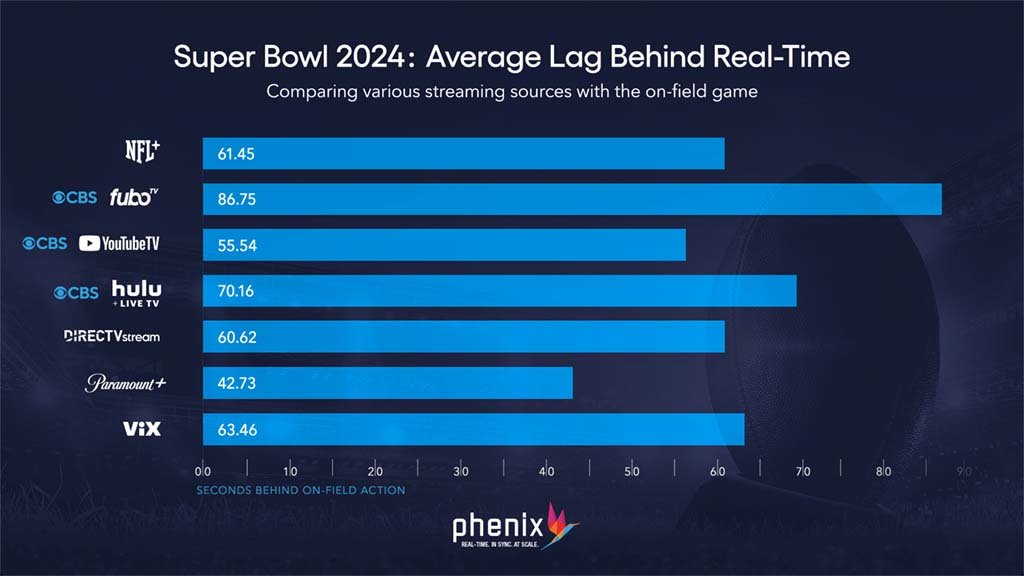Real-Time Streaming Gains Foothold In Sports Production, Online Betting
How will marquee events like the Super Bowl handle latency?

Intensifying demand for ultralow-latency streaming solutions in sportscasting and other live video scenarios is outpacing efforts to meet goals with conventional streaming, fueling prospects for greater reliance on alternative infrastructures.
The long-simmering debate over what to do about latency is coming to a boil, with the Super Bowl looming as an annual reminder of how bad the problem can be even after years of efforts to do better than the prevailing Hypertext Transport Protocol (HTTP) streaming infrastructure. Adding to the challenges confronting HTTP streaming are financially attractive use cases like microbetting and remote live sports production, which depend on ultralow latencies that are beyond the reach of the dominant HTTP-based HLS and MPEG DASH streaming modes with simultaneous viewing experiences sometimes scaling into the millions.
Often referred to as “real-time streaming,” with sub-half-second lag times falling below human perceptions of any delay between end points, such capabilities are supported by a dozen or more providers of cloud platforms that rely on the WebRTC (Real-Time Communication) protocol stack, which is incompatible with HTTP streaming. Most of these platforms far exceed the scaling capacities, app versatility and other capabilities of video conferencing systems but do support multidirectional video communications, which can’t be duplicated with HTTP-based streaming.
These providers are bunched at one end of a debate spectrum that also includes many players arguing for far less ambitious outcomes and others who contend there are better, cheaper real-time alternatives to WebRTC in the offing. That last category includes a new protocol known as Media over QUIC (MoQ), under development by working groups at the Internet Engineering Task Force (IETF).
Low-Latency Streaming Goals Vary
Where people stand in the debate depends on which use cases are being prioritized and how soon any real-time requirements must be satisfied. While MoQ looks to outperform any option now available, advocates say it will take a few years to finalize at the IETF and then commercialize across the vast content delivery network (CDN) ecosystem.
“If you need streaming at those latencies now, WebRTC meets your needs today,” said Will Law, a key participant in the IETF effort and the chief architect for cloud technology at CDN operator Akamai. But he advises those who don’t see an immediate need for real-time connectivity to bide their time, with the understanding the MoQ standard will one day lead to real-time multidirectional streaming with key advantages over WebRTC, including compatibility the latter lacks with the existing CDN system.
Many operators, at least for now, just want to do away with the “spoiler” effect experienced by streaming audiences when they’re in earshot of outbursts from TV viewers who are watching events unfold much closer to real time, sometimes by as much as a half-minute or more.
Get the TV Tech Newsletter
The professional video industry's #1 source for news, trends and product and tech information. Sign up below.
In the case of last year’s Super Bowl, streaming viewers—who spent a Super Bowl-record aggregate of 2.64 billion minutes watching the game on seven OTT services—experienced average lag times behind on-field action ranging from a low of 42.73 seconds for Paramount+ to a high of 86.75 seconds for Fubo, according to calculations conducted by WebRTC platform provider Phenix Real Time Solutions.

The Phenix study also highlighted the inconsistency of streaming performance, with a 128-second spread between the lowest and highest latencies recorded on the Fubo platform. As evidenced by similar results reported by Phenix from 2023 and previous Super Bowls, just lowering latency enough to get rid of the spoiler effect is no cakewalk.
That point was brought home in September at the IBC Show with a demonstration revealing the outcome of a months-long IBC Accelerator project led by Comcast and the U.K.’s BT. The team’s hard-wrought reductions in latency contributions from encoding, packaging, buffering and other processes produced an overall cut in latency to 1.8 seconds on 4K live sports streams delivered over MPEG DASH and HLS.
Beyond Beating the Spoiler Effect
Scalable live sports streaming at 1.8-second end-to-end latencies would certainly be a huge improvement over the current state of affairs. But the Accelerator team acknowledged that implementing its approach in real-world operations at mass scales could take some time and, in any event, would not satisfy the need for what WebRTC platforms are delivering.
These are the capabilities required to support a wealth of next-generation consumer applications infused with video-enabled social interactions among participants, which, along with microbetting, include watch parties, game shows, live sales presentations, online casino gambling, multiplayer game playing, distributed esports competitions, photorealistic group engagement in extended reality (XR) environments and much else. In all these cases, multidirectional—as well as real-time—streaming is essential.
The problem with WebRTC is that more money must be spent to reach mass audiences than is the case with conventional one-way streaming supported by CDNs. Or, as Comcast technology fellow Alex Giladi put it at IBC, “The difference between what you can get out of adaptive streaming and out of WebRTC is large but not large enough to justify wholesale change.”
That’s true when the goal is nothing more than eliminating the spoiler effect. If there’s a return to be obtained on putting a WebRTC platform to use, though, it can be well worth paying an incremental premium to deliver what amounts to a premium service.

On a track separate from consumer applications, many entities, especially in sports, are hoping to lower production costs with real-time streaming on the back end to enable centralized video processing that eliminates the need for expensive mobile production trucks and crews at event venues.
For example, Verizon’s business unit, which has taken a leading role in enabling advances in in-venue mobile viewing experiences for sports fans, is also working with sports producers to facilitate remote production through real-time connectivity between venues and distant production studios.
“You can’t have remote production unless there are instantaneous connections,” says Josh Arensberg, chief technology officer for Media & Entertainment at Verizon Business. “My goal is to actually enable the industry to do this and support it across a number of partners.”
Chris Allen, CEO of Red5, another WebRTC-based platform supplier, says, “WebRTC streaming is, I think, finally mature, and everybody is coming around to the fact that this is the right way to do this stuff.” Red5, which Allen says is undergoing remote production trials with multiple sports and new organizations, has partnered with Zixi to facilitate next-gen sports productions through direct tie-ins between the Zixi playout transport platform and remote production workflows that rely on RTIS supplied by Red5.
Putting real-time interactive connectivity to work immediately in live production scenarios has important implications for wide use in distribution down the road, Allen suggests.
“My theory is it’s going to help accelerate a lot of end-user experiences as well,” he says. When producers “start using this stuff in production, then it makes it a lot easier to transfer to the consumer and create interactive apps and everything else as we go.”—Fred Dawson
WebRTC is a peer-to-peer communications protocol stack based on the Real-Time Transport Protocol (RTP) used in internet voice and video communications. Streaming platforms built on WebRTC require distributed deployments of intelligently orchestrated cloud resources operating outside the HTTP domain, which can involve a huge volume of servers to reach massive scales.
Finding use cases where the returns are certain enough to overcome resistance to the spend is the challenge faced by all the WebRTC platform providers. But after several years of piecemeal progress, they’re starting to make some significant headway.
Microbetting—a subset of live in-game betting tied to wagering on imminent actions—is a hot use case that many advocates believe could get a lot hotter if people could bet on what they’re seeing in real time. “Online betting as a whole is typically done through sports books like FanDuel and DraftKings based on data rather than what bettors are seeing on their video screens,” Phenix Chief Marketing Officer Jed Corenthal said. “Delivering video so it syncs up with microbetting options like what the next pitch is going to be in a baseball game would deliver a much better experience.”
Microbetting Gains Momentum
Last year, just six-plus years after the U.S. Supreme Court legalized online betting in the states, in-game betting accounted for about 20% of the $14 billion wagered digitally, according to Grandview Research. The advantage of increasing audience engagement generated by microbetting is obvious and well worth pursuing, said Kelly Pracht, CEO of nVenue, a leading enabler of the AI-driven data aggregation and analysis that goes into calculating odds and setting up microbetting options delivered by sportsbooks.
“We’re excited about near-zero video streaming,” Pracht says. At this still-early stage in its market evolution, microbetting remains “a little disjointed,” she acknowledges. But with providers like Phenix available to support real-time streaming, she said she’s confident the industry will overcome obstacles to “bringing it together.”
There are formidable challenges to directly linking microbet bookmaking to what people are seeing on screen, especially if that entails going beyond handhelds to direct tie-ins with real-time streaming to smart TVs. But compared to what’s already been achieved by suppliers like nVenue, the climb doesn’t look all that steep.
Pracht notes the volume of real-time information nVenue processes to support its bookmaking clients’ microbetting options with NFL, NBA and MLB games has reached 480 trillion data points annually. “It takes a lot of technology to turn all that data into creating odds on what’s going to happen next,” she said.
Fred Dawson, principal of the consulting firm Dawson Communications, has headed ventures tracking the technologies and trends shaping the evolution of electronic media and communications for over three decades. Prior to moving to full-time pursuit of his consulting business, Dawson served as CEO and editor of ScreenPlays Magazine, the trade publication he founded and ran from 2005 until it ceased publishing in 2021. At various points in his career he also served as vice president of editorial at Virgo Publishing, editorial director at Cahners, editor of Cablevision Magazine, and publisher of premium executive newsletters, including the Cable-Telco Report, the DBS Report, and Broadband Commerce & Technology.

